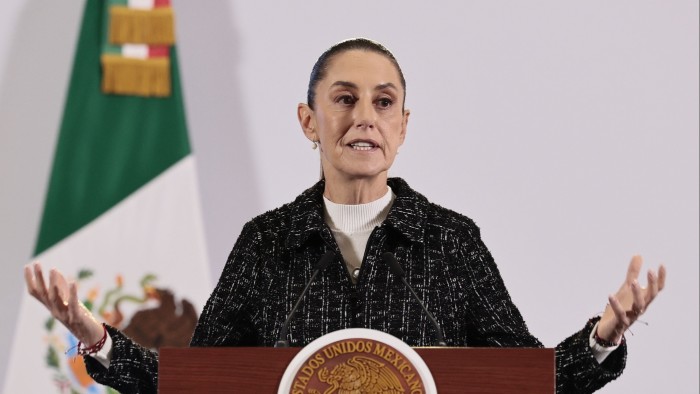Mexico ups deficit forecast as economists warn of slowing growth

Unlock the Editor’s Digest for free
Roula Khalaf, Editor of the FT, selects her favourite stories in this weekly newsletter.
Mexico’s government plans to run a larger deficit than previously expected next year as economists warned that its growth forecast was too optimistic because the country faces an economic slowdown and Donald Trump’s tariff threats.
Mexico’s net borrowing has hit 5.9 per cent of GDP, the highest level since the 1980s, after former President Andrés Manuel López Obrador spent more on social programmes and signature infrastructure projects in the run-up to this year’s election. His party won a landslide victory, but successor President Claudia Sheinbaum has inherited the task of restoring fiscal credibility.
On Friday Sheinbaum’s government said it would cut the deficit to 3.9 per cent of GDP next year, but that is still higher than the 3.5 per cent target she had suggested last month.
The package presented to Mexico’s Congress included sharp cuts to spending across many areas including security, healthcare and defence. It increased spending on social programmes and passenger rail and also included more than $6bn (136bn pesos) in debt payments for struggling state oil company Pemex.
“Compared to other countries in the world, [the budget] seems relatively reasonable, but it implies an increase in the debt-to-GDP ratio to 51.4 per cent, and that level for Mexico is high,” said Luis de la Calle, an economic consultant and former trade negotiator. “It’s clear that to be successful on public finances, this government needs a lot of private investment to expand the tax base.”
The forecast cut in net borrowing — equivalent to 2 per cent of GDP — is the largest since at least the 1990s, according to IMF data.
The government’s projection assumes that Mexico’s growth rate will accelerate next year to between 2 and 3 per cent, up from the 1.4 per cent which analysts project for this year. However a central bank survey in October — before the US election — showed that on average analysts expect growth to be just 1.2 per cent in 2025.
“It’s a relatively responsible budget but it’s not as credible as one would have liked . . . [it] basically exploits the goodwill of investors to take at face value the promises of good behaviour from the government,” said Ernesto Revilla, Chief Economist for Latin America at Citi.
Several analysts said they thought the real deficit would end up higher than the Finance Ministry was forecasting, partly due to lower growth and the difficulty of carrying out sharp public spending cuts.
“I think many of the assumptions on the revenue side but particularly on the expenditure side are a bit stretched . . . It’s not an easy budget to execute,” Revilla said.
Investors in Latin America’s second-largest economy have been unnerved by the ruling party’s radical reform agenda and Trump’s threats of blanket tariffs. Since the Morena party won a supermajority in June, the peso has weakened around 15 per cent against the dollar.
Before the budget was published this week Moody’s lowered its Mexico outlook to “negative”. It rates the country’s debt at Baa2, two notches above junk.
Friday’s budget for 2025 would see public investment cut by 14 per cent to 996bn pesos, including 149bn pesos for an effort to revive passenger railways. Of this, 40bn pesos would go to the massive Maya Train project in the Yucatán peninsula, which was started by López Obrador.
Spending on social programmes also increased, partly due to a new cash payment for women aged between 60 and 64.
There were sharp cutbacks across most other areas of government, including double-digit reductions in health and security, even though citizens have seen the quality of services deteriorate in recent years.
“The new president didn’t have a lot of room to move,” said Alejandra Macías, executive director of think-tank CIEP. “The deficit was reduced but at the cost of cuts that really leave institutions and sectors weaker . . . It’s going to cost us a lot in the coming years.”
Mexico has long had low levels of taxation, at just 17 per cent of GDP compared to an OECD average of 34 per cent in 2022. During her election campaign, Sheinbaum played down the need for fiscal reform but on Friday said that if it were needed her team would work on it next year.
“Given the public finances challenges in the next few years, the government needs to design and implement fiscal reform . . . [focusing] on reducing informality and tax evasion,” analysts at BBVA Mexico said.
Congress still has to approve the budget proposal, though few significant changes are expected.
#Mexico #ups #deficit #forecast #economists #warn #slowing #growth




